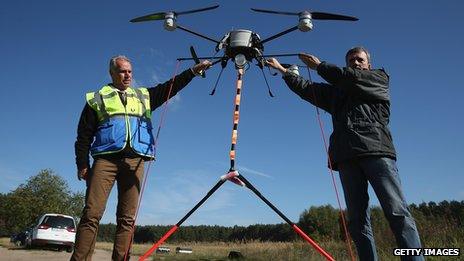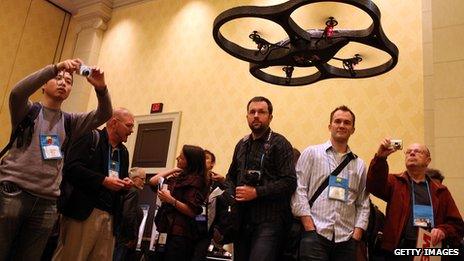Rise of the drone hobbyists
- Published
DIY drones: Enthusiasts making their own aircraft
People around the world are building their own drones. They offer a glimpse of what life will be like when the skies are filled with small, flying robots - and drones become as common as smartphones.
Raphael Pirker was sitting on a bench at Washington Square Park on a blustery Friday in New York. A small drone called Discovery, a remotely controlled aircraft made by his company, TBS Avionics, was on the bench next to him.
Nearby another drone was flying near a fountain. Even before he saw the drone, he heard it. "It's just like this, 'bzz-bzz'," he said.
An onlooker watched the aircraft - "a beginner drone", Pirker said, crash into the pavement.
Down the block hundreds of people had gathered at New York University for a Drones and Aerial Robotics Conference, external. Like Pirker, many of them were carrying their own drones.

Roboticist Heather Knight and a robot on display at the New York conference
On a global scale the US and Israel are the world's biggest manufacturers of drones. Yet some European officials want to change the dynamic.
Michel Barnier, a European Union commissioner, told a group of French journalists, external in July that Europeans should make their own drones, rather than rely exclusively on US- and Israeli-made ones.
Pirker is also planning for the future. In Europe drones are used to make movies (see Smurfs 2). In the UK officials have granted permission to more than 130 companies and government agencies to fly drones, according to an Aerospace America report, external.
In the US the Federal Aviation Administration has approved the use of drones for police and government agencies, issuing about 1,400 permits over the past several years.
The civilian air space will reportedly be open to all kinds of drones in Europe by 2016 - and in the US by 2015. Many of these machines will be small - like the ones Pirker makes.
And cheap. You can make a drone, explained South-African-born Mike Winn, of Drone Deploy, for $500 (£310).

Drones, shown above, are used to prevent theft of phone equipment in Germany
Pirker, 29, is a Swiss-Austrian who lives in Hong Kong - "for business reasons". He wears rimless glasses, the kind once worn by Apple guru Steve Jobs, and he has light blue eyes. Pirker and the others at the conference belong to a new breed of drone maker. Many are global travellers, and most grew up on drones.
At the conference 14-year-old Riley Morgan approached Pirker, carrying a drone he had made. Another enthusiast, Russell de la Torre, who is 31, made his first robot, "a remote-controlled truck with cardboard boxes", at age 12.
Pirker started building model airplanes when he was six. "I got bored because they were just flying circles around," he said, spinning his hand in the air in a lazy manner. As an adult he said: "I had this crazy idea of flying [a drone] over the Statue of Liberty.
"Everybody said, 'Don't do that - you're doing to get shot.'"
"It was a strange feeling," he said, describing the day three years ago when the drone flew, as shown in this head-spinning footage, external. "It felt a little bit eerie because you're flying past so much history, you know, about America."
Drones give one a different perspective. "It's not the plane that turns in the air - it's the world that turns," he said.
Drones do more than provide material for trippy videos, though. They help farmers check on crops and allow journalists to report stories. But even small drones - like the kind Pirker makes - cause problems.
"Every country has different rules, but we follow our own," Pirker said. "We're not going to hurt anybody. We do it with a little bit of play." Not everyone sees his drones as whimsical.
Federal Aviation Administration officials tried to fine Pirker $10,000 for operating a drone in Charlottesville, Virginia, in October 2011. His lawyer filed a motion, external three weeks ago, describing the aircraft, a "five-pound radio-controlled model airplane constructed of styrofoam", as harmless.

A drone controlled by an iPhone, shown in Nevada in 2010
Small drones are usually benign. Yet they can be lethal. Roman Pirozek, 19, died last month in Brooklyn, NY, when his remote-controlled helicopter spun out of control - and hit him in the head.
Small drones also provide new ways to spy. A Seattle woman felt uneasy about a drone outside her window, as she reported earlier this year on a blog, external.
Amie Stepanovich, director of a project on domestic surveillance at the Electronic Privacy Information Center, thinks drones are cool - and said Pirker's video was "gorgeous".
But drones also worry her. "They are helping to usher in a new age of physical surveillance," she said. "They provide a platform for some of the most invasive surveillance technologies we've ever seen."
Pirker has a different perspective. Rather than causing anxiety, drones have helped him get over his fear of heights - a handicap, since he lives in a high-rise in Tseung Kwan O, outside of Hong Kong, on the 40th floor.
As he sat on the park bench in New York, he stuck out his leg and jiggled it, showing what used to happen when he looked down from a window in a tall building.
Now he said: "I just step back."
- Published2 August 2013
- Published27 September 2013